
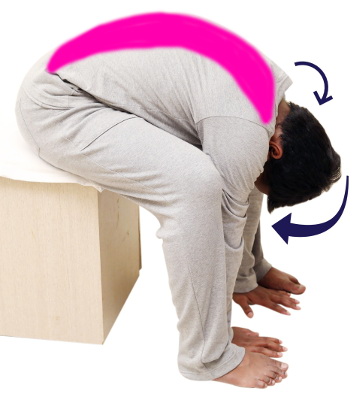
Steps for doing:
- The coloured part in being stretched.
- Sit over a couch
- Bend towards floor as shown
- Touch the floor with both palms
- Head flexed towards chest for better stretch
- Hold the same position for 10-20 seconds
In this video we are going to stretch erector spinae & interspinales muscle
The coloured part in being stretched as shown
The arrow indicates the direction of stretch
- The superficial group of muscle which connects all the spinal region from neck to the low back region.
- Symptoms refer to all spinal joints, neck, abdomen, trunk, groin, and hip regions.
- Symptoms may include pain, numbness, hypersensitivity, compression of adjacent blood vessels and nerves.
- Commonly related to disease such as spinal joint dysfunction, spinal joint osteoarthritis, spinal nerve compression, facet syndrome and others.
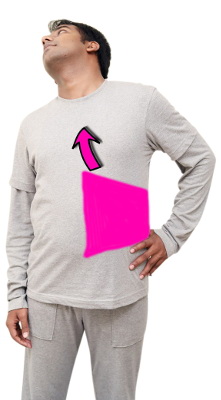
Steps for doing:
- The coloured part in being stretched.
- Stand straight as shown.
- Hold your right hip region.
- Bend backwards and towards left.
- Pull your chest backwards.
- Hold the same position for 10-20 seconds
In this video we are going to stretch External oblique muscle
The coloured part in being stretched as shown
The arrow indicates the direction of stretch
- This muscle is responsible for rotation and flexion of lumbar Spine, may cause abdominal colic ,and can mimic acute abdomen
- Symptoms refer to lumbar spinal joints, abdomen, pelvis, groin, and chest wall regions.
- Symptoms may include pain, numbness, hypersensitivity, compression of adjacent blood vessels and nerves.
- Commonly related to disease such as heart burn, abdominal cramps, vomiting, diarrhea, indigestion, dysmenorrhea and various gastrointestinal diseases
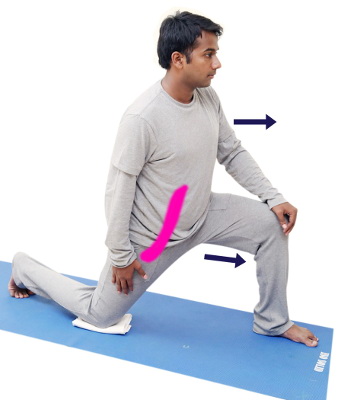
Steps for doing:
- The coloured part in being stretched.
- Right knee over towel as shown.
- Left leg positioned in front as shown.
- Move your body forward by fixing right knee.
- Keep your spine straight.
- Hold the same position for 10-20 seconds
In this video we are going to stretch Ilio Psoas muscle
The coloured part is being stretched as shown.
The arrow indicates the direction of stretch
- The stabilizer of the lumbar spine, responsible for difficulties in rolling over bed, bending side wards, and difficulty in climbing staircases.
- Symptoms refer to lumbar spinal joints, hip joints, abdomen, groin, and leg regions.
- Symptoms may include pain, numbness, hypersensitivity, compression of adjacent blood vessels and nerves.
- Commonly related to disease such as sciatica, lumbar nerve compression, lumbar joint and SI joint dysfunction, bursitis and others.
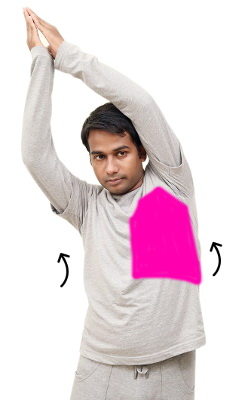
Steps for doing:
- The coloured part in being stretched.
- Hip and spine in straight line.
- Hold the right and left upper limb over head as shown.
- Move towards left side as shown.
- Pull right side chest towards left.
- Cross right leg over left for stability in standing position.
- Hold the same position for 10-20 seconds
In this video we are going to stretch Intercostalis muscle
The coloured part in being stretched as shown
The arrow indicates the direction of stretch
- This muscle is responsible for restricted rotation of the thoracic Spine, chest pain, Shortness of breath
- Symptoms refer to thoracic spinal joints, neck, abdomen, lung , chest wall regions.
- Symptoms may include pain, numbness, hypersensitivity, compression of adjacent blood vessels and nerves.
- Commonly related to disease such as rib joint dysfunction, costochondritis, myocardial infarction or herpes zoster, Cardiac arrhythmia
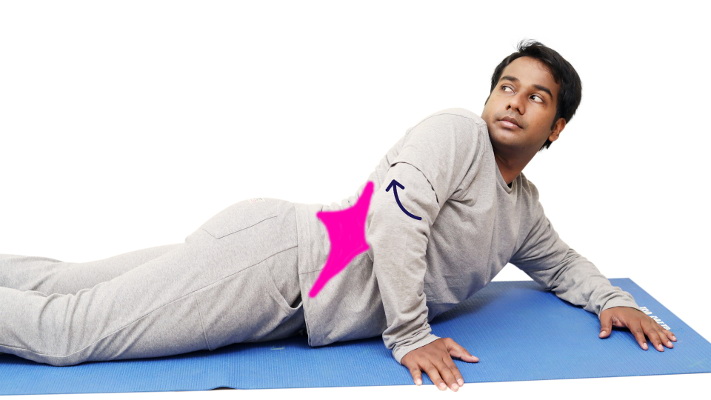
Steps for doing:
- The coloured part in being stretched.
- Lower body abuts floor.
- Upper body above hip raised and rotated towards left as shown.
- Hold the same position for 10-20 seconds
In this video we are going to stretch Internal oblique muscle
The coloured part in being stretched as shown
The arrow indicates the direction of stretch
- This muscle is responsible for rotation and flexion of lumbar Spine, may cause abdominal colic ,and can mimic acute abdomen
- Symptoms refer to lumbar spinal joints, abdomen, pelvis, groin, and chest wall regions.
- Symptoms may include pain, numbness, hypersensitivity, compression of adjacent blood vessels and nerves.
- Commonly related to disease such as heart burn, abdominal cramps, vomiting, diarrhea, indigestion, dysmenorrhea and various gastrointestinal diseases
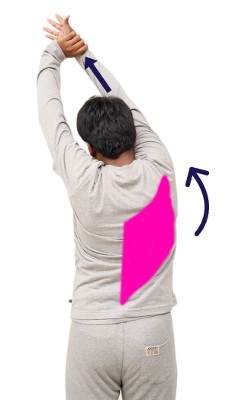
Steps for doing:
- The coloured part in being stretched.
- Hold Hip and spine in straight line.
- Hold the right upper limb over head as shown
- Pull towards left and forward with left hand as shown
- Cross right leg over left for stability in standing position.
- Hold the same position for 10-20 seconds
In this video we are going to stretch Latissimus dorsi muscle
The coloured part in being stretched as shown
The arrow indicates the direction of stretch
- Muscle responsible for midthoracic back pain
- Symptoms refer to scapula, loin, shoulder, medial arm, forearm, ulnar aspect of hand, till 4th and 5th fingers
- Symptoms may include pain, numbness, hypersensitivity, compression of adjacent blood vessels and nerves.
- Commonly related to disease such as spinal joint dysfunction from T7 to L4, intrathoracic disease, heart disease, cervical nerve compression, tendinitis and others.

Steps for doing:
- The coloured part in being stretched.
- Hold Hip and spine in straight line
- Hold the right upper limb over head as shown
- Pull your right side body towards left as shown
- Cross left leg over right for stability in standing position.
- Hold the same position for 10-20 seconds
In this video we are going to stretch Quadratus lumborum muscle
The coloured part in being stretched as shown
The arrow indicates the direction of stretch
- The stabilizer of the lumbar spine, responsible for difficulties in rolling over bed, bending side wards, and difficulty in climbing staircases.
- Symptoms refer to lumbar spinal joints, hip joints, abdomen, groin, and leg regions.
- Symptoms may include pain, numbness, hypersensitivity, compression of adjacent blood vessels and nerves.
- Commonly related to disease such as sciatica, lumbar nerve compression, lumbar joint and SI joint dysfunction, bursitis and others.
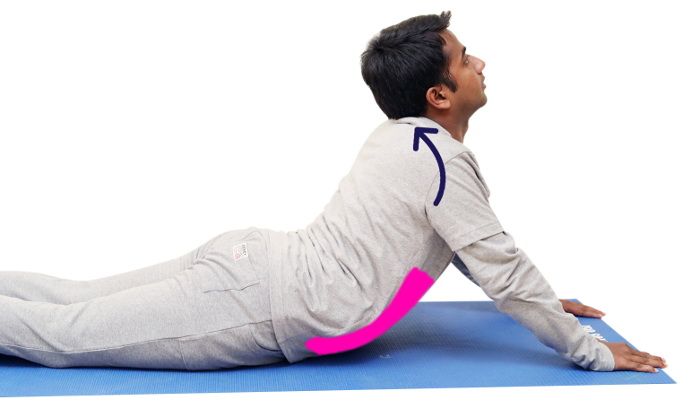
Steps for doing:
- The coloured part is being stretched.
- Lie down as shown.
- Lift upper body alone(above hip).
- Lower body abuts floor.
- Hold both elbows in straight position for better stretch.
- Hold the same position for 10-20 seconds
In this video we are going to stretch Rectus abdominis muscle
The coloured part in being stretched as shown
The arrow indicates the direction of stretch
- This muscle is responsible for back pain especially in the midthorax and low lumbar region
- Symptoms refer to spinal joints, abdomen, pelvis, groin, and chest wall regions.
- Symptoms may include pain, numbness, hypersensitivity, compression of adjacent blood vessels and nerves.
- Commonly related to disease such as lower abdominal pain, pelvic pain, dysmenorrhea sacroiliac joint dysfunction, lumbar joint dysfunction
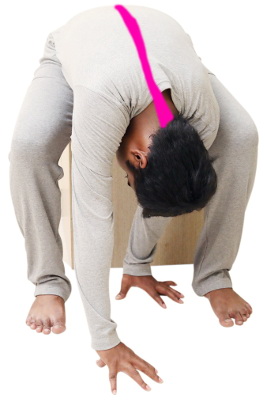
Steps for doing:
- The coloured part is being stretched.
- Sit over a couch.
- Bend towards floor as shown.
- Touch the floor with both palms as shown
- Head rotated and flexed towards right for better stretch
- Hold the same position for 10-20 seconds
In this video we are going to stretch Transverso-spinalis group of muscles
The coloured part in being stretched as shown
The arrow indicates the direction of stretch
- The deep group of muscle which connects all the spinal region from neck to the low back region.
- Symptoms refer to all spinal joints, neck, abdomen, trunk, groin, lung , chest and hip regions.
- Symptoms may include pain, numbness, hypersensitivity, compression of adjacent blood vessels and nerves.
- Commonly related to disease such as spinal joint dysfunction, spinal joint osteoarthritis, facet syndrome, sciatica and others.
 Brain and Spine Secrets
Brain and Spine Secrets